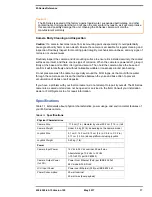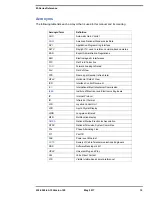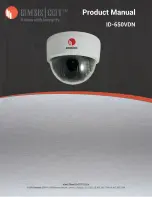
Installing M-Series Camera Systems
432-0003-60-12 Version 100
May 2017
5
Documentation Conventions
For safety, and to achieve the highest levels of performance from the M-Series system, always
follow the warnings and cautions in this manual when handling and operating the M-Series camera
system.
Warning!
Caution!
Note:
Notes call attention to information that is especially significant to understanding and
operating the equipment.
Warnings and Cautions
Warning!
Caution!
Warning notices are used to emphasize that hazardous voltages, currents, temperatures, or
other conditions that could cause personal injury or death exist with this equipment, or may be
associated with its use.
Caution notices are used where equipment might be damaged if care is not taken or an
operation might have an unexpected outcome.
Do not use the M-Series imaging system as the primary navigation system. Use it in conjunction
with other navigation aids and a primary manual navigation system.
Use of insufficient wire gauge can result in fire.
The M-Series system is not designed to operate in an enclosed environment in the presence of
flammable gases. Failure to follow this warning may result in explosion or fire.
The M-Series camera body is a remotely and automatically controlled device. Ensure camera
motion has been disabled before cleaning surfaces that can cause pinch hazards.
Do not open the M-Series camera unit for any reason. Disassembly of the camera (including
removal of the cover) can cause permanent damage and will void the warranty.
Be careful not to leave fingerprints on the M-Series camera optics.
The M-Series requires a power supply of 12 Vdc to 24 Vdc nominal, 50 watt maximum. Absolute
voltage range: 10 Vdc to 32 Vdc. Operating the camera outside of the specified input voltage
range or the specified operating temperature range can cause permanent damage.
Ensure power is removed before accessing power wires during installation or removal of system
components. DO NOT HOT SWAP components (such as the JCU). Damage to equipment or
injury to personnel may result.
During installation, ensure the cables exiting the bottom of the camera are not in contact with
sharp edges, do not bend at sharp angles, and are not pinched between the bottom of the
camera and the mounting surface. Do not pull on the cables with excessive force.
Follow industry standard best practices to avoid subjecting the camera to galvanic corrosion and
electrolytic corrosion (electrolysis), especially with regards to the camera connections, camera
base, its mounting surface, and all fasteners.
Ensure the camera is installed in a location that will allow it to be accessed for regular periodic
cleaning (fresh water rinse), inspection of mounting point integrity and mechanical soundness,
and preventative maintenance.






































